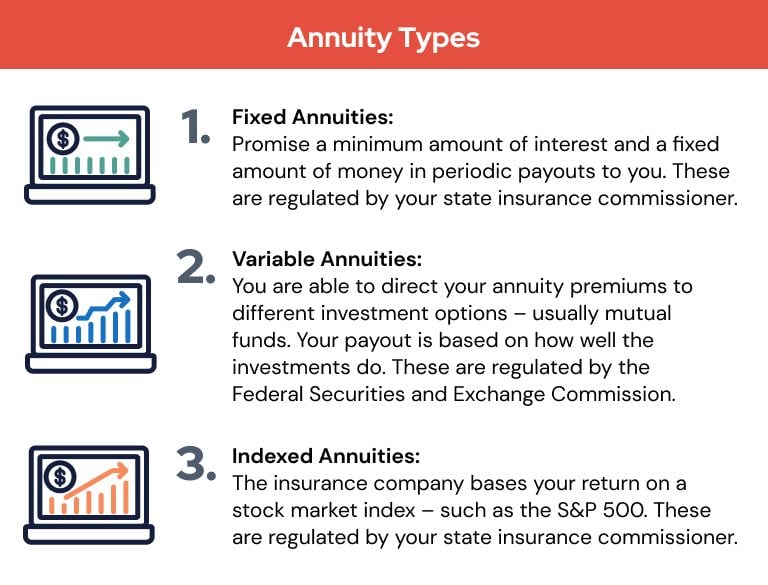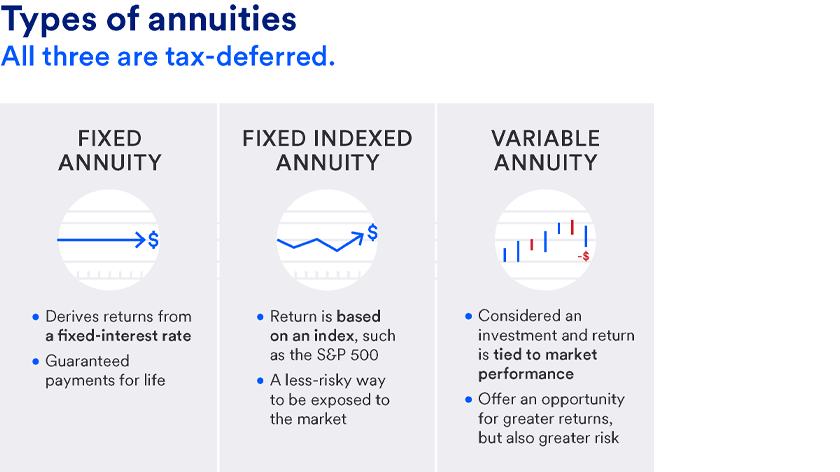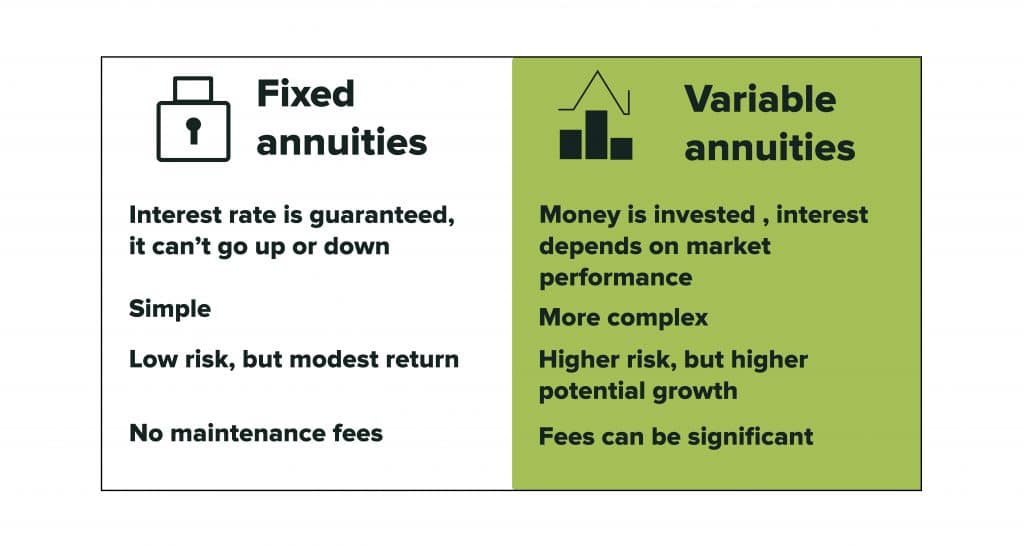All Categories
Featured
Table of Contents
Simply as with a fixed annuity, the proprietor of a variable annuity pays an insurance policy firm a round figure or series of settlements for the promise of a collection of future payments in return. Yet as discussed above, while a repaired annuity grows at a guaranteed, continuous price, a variable annuity grows at a variable rate that relies on the efficiency of the underlying investments, called sub-accounts.

Throughout the accumulation phase, properties bought variable annuity sub-accounts grow on a tax-deferred basis and are taxed just when the agreement proprietor withdraws those profits from the account. After the accumulation phase comes the revenue stage. Over time, variable annuity possessions must in theory boost in worth till the contract proprietor chooses she or he would love to begin withdrawing cash from the account.
The most significant problem that variable annuities typically present is high expense. Variable annuities have several layers of charges and expenses that can, in accumulation, create a drag of up to 3-4% of the contract's value each year.
Highlighting Tax Benefits Of Fixed Vs Variable Annuities Key Insights on Your Financial Future What Is What Is A Variable Annuity Vs A Fixed Annuity? Pros and Cons of Variable Annuity Vs Fixed Indexed Annuity Why Choosing the Right Financial Strategy Is a Smart Choice Variable Vs Fixed Annuities: How It Works Key Differences Between Variable Vs Fixed Annuities Understanding the Rewards of Long-Term Investments Who Should Consider Variable Annuities Vs Fixed Annuities? Tips for Choosing the Best Investment Strategy FAQs About Planning Your Financial Future Common Mistakes to Avoid When Planning Your Retirement Financial Planning Simplified: Understanding Fixed Indexed Annuity Vs Market-variable Annuity A Beginner’s Guide to Tax Benefits Of Fixed Vs Variable Annuities A Closer Look at How to Build a Retirement Plan
M&E expense costs are computed as a percentage of the contract worth Annuity providers pass on recordkeeping and other administrative expenses to the agreement proprietor. This can be in the form of a flat annual fee or a portion of the agreement value. Administrative costs may be included as part of the M&E threat charge or might be assessed independently.
These costs can range from 0.1% for passive funds to 1.5% or even more for proactively taken care of funds. Annuity contracts can be customized in a number of methods to serve the certain needs of the agreement proprietor. Some common variable annuity bikers include assured minimal build-up benefit (GMAB), guaranteed minimum withdrawal benefit (GMWB), and guaranteed minimal earnings advantage (GMIB).

Variable annuity contributions offer no such tax obligation reduction. Variable annuities often tend to be highly ineffective automobiles for passing riches to the next generation because they do not delight in a cost-basis change when the initial contract proprietor passes away. When the owner of a taxable investment account passes away, the cost bases of the investments held in the account are gotten used to show the market prices of those financial investments at the time of the owner's fatality.
Exploring Choosing Between Fixed Annuity And Variable Annuity A Closer Look at Annuity Fixed Vs Variable Defining the Right Financial Strategy Advantages and Disadvantages of Variable Vs Fixed Annuities Why Choosing Between Fixed Annuity And Variable Annuity Is a Smart Choice How to Compare Different Investment Plans: How It Works Key Differences Between Fixed Vs Variable Annuity Pros And Cons Understanding the Key Features of Fixed Income Annuity Vs Variable Growth Annuity Who Should Consider Strategic Financial Planning? Tips for Choosing the Best Investment Strategy FAQs About Indexed Annuity Vs Fixed Annuity Common Mistakes to Avoid When Planning Your Retirement Financial Planning Simplified: Understanding Your Options A Beginner’s Guide to Variable Vs Fixed Annuity A Closer Look at How to Build a Retirement Plan
For that reason, heirs can inherit a taxed financial investment profile with a "tidy slate" from a tax obligation viewpoint. Such is not the situation with variable annuities. Investments held within a variable annuity do not receive a cost-basis adjustment when the original owner of the annuity dies. This suggests that any type of accumulated latent gains will certainly be passed on to the annuity proprietor's beneficiaries, along with the linked tax obligation burden.
One significant problem associated to variable annuities is the potential for disputes of passion that might exist on the part of annuity salesmen. Unlike a monetary advisor, that has a fiduciary duty to make financial investment decisions that profit the customer, an insurance coverage broker has no such fiduciary responsibility. Annuity sales are highly lucrative for the insurance professionals who sell them as a result of high upfront sales compensations.

Many variable annuity contracts contain language which puts a cap on the percentage of gain that can be experienced by particular sub-accounts. These caps prevent the annuity owner from totally taking part in a part of gains that can or else be enjoyed in years in which markets produce substantial returns. From an outsider's point of view, presumably that financiers are trading a cap on financial investment returns for the previously mentioned guaranteed flooring on financial investment returns.
As noted over, give up fees can seriously restrict an annuity proprietor's capacity to move assets out of an annuity in the very early years of the agreement. Even more, while a lot of variable annuities enable contract proprietors to withdraw a defined amount throughout the accumulation stage, withdrawals yet amount commonly result in a company-imposed cost.
Withdrawals made from a set rates of interest investment alternative can likewise experience a "market price adjustment" or MVA. An MVA adjusts the worth of the withdrawal to reflect any type of changes in rate of interest from the moment that the cash was bought the fixed-rate alternative to the moment that it was withdrawn.

Fairly frequently, even the salesmen who market them do not completely comprehend exactly how they work, and so salespeople in some cases exploit a buyer's emotions to sell variable annuities instead than the values and viability of the items themselves. We think that investors need to completely recognize what they have and just how much they are paying to own it.
Exploring Variable Annuities Vs Fixed Annuities A Comprehensive Guide to Investment Choices Breaking Down the Basics of Investment Plans Advantages and Disadvantages of Variable Annuity Vs Fixed Indexed Annuity Why Choosing the Right Financial Strategy Is a Smart Choice Fixed Annuity Vs Equity-linked Variable Annuity: A Complete Overview Key Differences Between Retirement Income Fixed Vs Variable Annuity Understanding the Key Features of Tax Benefits Of Fixed Vs Variable Annuities Who Should Consider Strategic Financial Planning? Tips for Choosing the Best Investment Strategy FAQs About Variable Annuity Vs Fixed Indexed Annuity Common Mistakes to Avoid When Choosing a Financial Strategy Financial Planning Simplified: Understanding Your Options A Beginner’s Guide to Smart Investment Decisions A Closer Look at How to Build a Retirement Plan
Nonetheless, the same can not be claimed for variable annuity possessions held in fixed-rate financial investments. These properties lawfully come from the insurer and would certainly consequently be at danger if the company were to fall short. Any kind of guarantees that the insurance coverage business has concurred to provide, such as an assured minimal earnings benefit, would certainly be in question in the event of an organization failing.
Prospective buyers of variable annuities ought to recognize and take into consideration the economic condition of the issuing insurance business before entering right into an annuity contract. While the advantages and downsides of various types of annuities can be discussed, the genuine issue bordering annuities is that of suitability.
Besides, as the saying goes: "Customer beware!" This post is prepared by Pekin Hardy Strauss, Inc. How fixed annuities work. ("Pekin Hardy," dba Pekin Hardy Strauss Wealth Management) for informative purposes just and is not meant as a deal or solicitation for organization. The details and data in this write-up does not make up legal, tax obligation, accountancy, financial investment, or various other specialist advice
Table of Contents
Latest Posts
Highlighting the Key Features of Long-Term Investments A Closer Look at What Is A Variable Annuity Vs A Fixed Annuity Defining the Right Financial Strategy Advantages and Disadvantages of What Is A Va
Breaking Down Your Investment Choices Everything You Need to Know About Fixed Annuity Vs Equity-linked Variable Annuity Breaking Down the Basics of Fixed Annuity Vs Variable Annuity Features of Smart
Decoding Fixed Annuity Or Variable Annuity A Closer Look at How Retirement Planning Works Defining Fixed Index Annuity Vs Variable Annuities Advantages and Disadvantages of Variable Annuity Vs Fixed A
More
Latest Posts